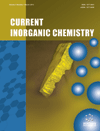- Home
- A-Z Publications
- Current Inorganic Chemistry (Discontinued)
- Previous Issues
- Volume 7, Issue 1, 2017
Current Inorganic Chemistry (Discontinued) - Volume 7, Issue 1, 2017
Volume 7, Issue 1, 2017
-
-
A New Route to [SbVW6O24]7- Anderson-Evans Polyoxometalate: Crystal Structures of Na7[SbW6O24]·16H2O and Na7[SbW6O24]·24H2O.
More LessAuthors: Anna A. Mukhacheva, Pavel A. Abramov and Maxim N. SokolovBackground: Polyoxometalates (POMs) represent a large class of polynuclear oxo-bridged early transition metal compounds with extraordinary rich variations of building modes and versatile chemical and physical properties. However, the antimonate-based Anderson-Evans POMs have received scarce attention. Herein we report easy transformation of [SbW9O33]9- into [SbW6O24]7- by oxidation of Sb3+ to Sb5+ with bromine w Read More
-
-
-
Solvent Triggered Transition of Electrical Conductivity of Polyoxometalate-based Hybrid with Ni-pyridyl-tetrathiafulvalene
More LessBackground: Polyoxometalate (POM) clusters are molecular metal-oxide that possess advantages in integrating functionalities at the molecular level. Redox activity is key characteristic of the POMs where the electron-withdrawing ability is changed according to environments that surroundings POMs. Achieving switching phenomena of electronic state of POMs are of great interest for various applications. Objective: Read More
-
-
-
Synthesis, Structural and Electrochemical Properties of the [SbIII 2SiMo12O40]4- anion, a Bicapped Keggin Polyoxometalate
More LessBackground: Polyoxometalates, especially those derived from the Kegin structure are able to exchange a large number of electrons through quasi-reversible redox processes. However, little is known about the redox behaviour of reduced bicapped Keggin ions. Thereby, this work represents the first electrochemical investigation of this Keggin-type ion. Objectives: The main objective of this study was to analyze the influence of th Read More
-
-
-
Synthesis, Structure and Electrochemistry of the Dinickel(II)-Containing 30-Tungsto-4-Phosphate [Ni2Na2(H2O)2(P2W15O56)2]18-
More LessBackground: Lacunary (vacant) heteropolyanions are a subclass of polyoxometalates (POMs) and are known to act as inorganic, polydentate ligands with a multitude of oxophilic electrophiles such as 3d metal ions. The family of Weakley-type POM sandwich structures is rather large, as they are known for Keggin- and Dawson-based capping units, for a multitude of 3d metal ions, as well as different tetrahedral heteroato Read More
-
-
-
Synthesis, Electrochemistry and Electro-Catalytic Properties of The Mixed Copper-Iron-Containing Sandwich-Type Polyoxometalates [(FeIIIOH)2CuII 2 (X2W15O56)2]14- and [(CuIIOH2)2FeIII 2(X2W15O56)2]14- (with X = AsV and PV)
More LessBackground: Sandwich-type polyoxometalates (POMs) of the Dawson family result from the reaction of the lacunary species [X2W15O56]12- (where X = As or P) with M, a "d" or "f" transition metal, yielding the compound [M4(H2O)2(X2W15O56)2]y- in which the metallic cluster M4O14(H2O)2 is sandwiched between two lacunary fragments [X2W15O56]12-. We have made significant progress as far as the determ Read More
-
-
-
Functionalization of Mo132 Keplerate Nanocapsules by Cyclic Carboxylates: L-proline vs Cyclopentanecarboxylate
More LessBackground: Keplerate-type capsules represent unique supramolecular objects displaying a tuneable spatially-restricted environment and are promising in many domains. In particular, some recent reports demonstrate that chemical transformations can occur specifically within the cavity, then acting as a nano-reactor. Some authors evidenced that the porous capsule provides internal active sites for catalytic transformatio Read More
-
-
-
Nickel(II) Coordination Clusters Based on N-salicylidene-4-chloro-o-aminophenol: Synthetic and Structural Studies
More LessBackground: The chemistry of nickel(II) clusters continues to attract the intense interest of many inorganic groups around the world for a variety of reasons, including its relevance to Molecular Magnetism. Objective: The primary objective of this study was to employ the polydentate Schiff base Nsalicylidene- 4-chloro-o-aminophenol in nickel(II) carboxylate chemistry for the synthesis of coordination clusters. Methods: The influen Read More
-
-
-
Iron(III) Clusters from Polydentate Schiff Base Ligands: Involvement of Non Heisenberg Interaction in [FeIII 3(μ2-OR)3(μ2-O2CPh)3]3+ Clusters
More LessBackground: The considerable interest in iron(III) oxo/hydroxo brigded polynuclear complexes stems from their relevance to diverse fields, from bioinorganic chemistry to molecular magnetic materials. The trinuclear oxo-centered carboxylato iron complexes have been extensively used as simple models in order to understand the magnetic interactions which have been interpreted in terms of the Heisenberg-Dirac-van Vlec Read More
-
Most Read This Month
Article
content/journals/cic
Journal
10
5
false
en


